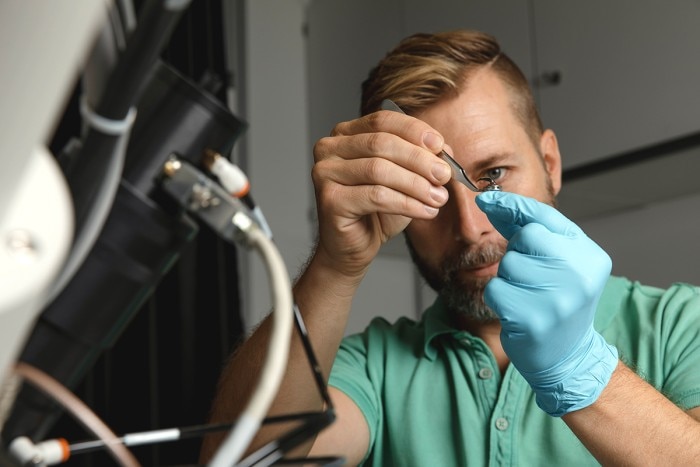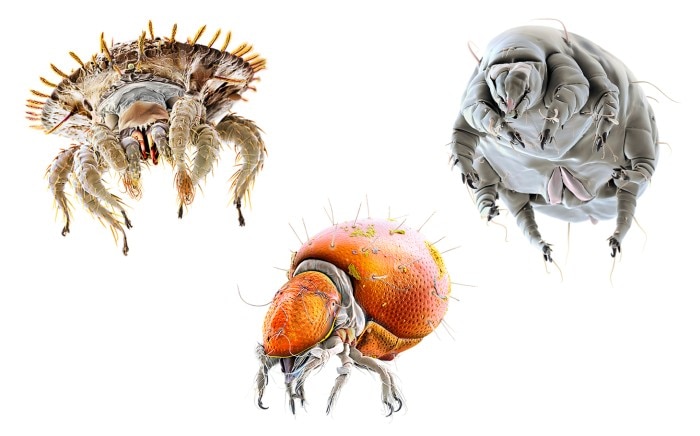MENU
CZ | CZK
CZ | CZK
No results found
Search Suggestions

Expedition into the Microcosmos
Explore Life Science
- Off the Bench
- Bright Minds
With a great love of detail, Martin Oeggerli brings microscopically tiny creatures and objects to life. Through his art, the prize-winning scientific photographer draws attention – and builds knowledge.
When Martin Oeggerli looks through his microscope, he embarks on a journey into another world. He discovers grotesque monsters, primeval forests and strange planets, enlarged by a factor of a thousand. His surreal-seeming photos could be used as inspiration for sci-fi novels, yet they are not only real, but often also amazingly ordinary. The forest is revealed to be a cross-section of the leaf of a fire potato, the planets are actually pollen, the monsters turn out to be mites. As a scientific photographer, Oeggerli has taken on the challenge of making the microcosmos – the world of microorganisms – visible and presenting it in an aesthetically pleasing form.
However, the 49-year-old, who lives near Basel, is innately a scientist. The microbiologist worked in cancer research at the University of Basel for seven years – until his father gave him a camera. “I had already taken thousands of pictures with it for my work within a few weeks”, reports Oeggerli. But the scientific perspective has since retreated ever more into the background: “Nowadays I’m one hundred percent an artist.”
Scanning instead of photography
The Swiss photographer, who receives his microscope slides from research colleagues, is no longer working with commercial digital cameras. These days he uses a scanning electron microscope; its electron beams scan the surface of the image section and, with that information, create a highly detailed three-dimensional image. However, this process also has a drawback when compared to photography: it does not reveal color. That means a lot of manual work for the artist on the computer in his studio: “For coloring, I do need up to 100 hours per image – with that, I get up to twenty completed works a year at maximum,” estimates Oeggerli.
First, the image is cropped. Pixel for pixel, level for level, the photographer assigns colors to the motifs in Photoshop, so that the different details become as visible as possible through these contrasting colors. “Humans have learned to differentiate, categorize, and assess what we see through color. That’s also reflected in my work.” Though he explains that the colors are not always faithful to the original, but rather down to artistic liberty: “That’s how I bring the scenes to life and make the invisible visible.”
Oeggerli’s shots are often featured in renowned publications, such as National Geographic, where they amaze laypeople as well as scientists. This attracts attention: Martin Oeggerli was recently awarded one of the world’s most prestigious prizes in scientific photography, the Lennart Nilsson Award. “It’s an honor and an acknowledgement of me and the images that I have created,” he says happily but modestly. The prize creates interest and informs people about a world that is itself little known in science and not universally appreciated.
However, the 49-year-old, who lives near Basel, is innately a scientist. The microbiologist worked in cancer research at the University of Basel for seven years – until his father gave him a camera. “I had already taken thousands of pictures with it for my work within a few weeks”, reports Oeggerli. But the scientific perspective has since retreated ever more into the background: “Nowadays I’m one hundred percent an artist.”
Scanning instead of photography
The Swiss photographer, who receives his microscope slides from research colleagues, is no longer working with commercial digital cameras. These days he uses a scanning electron microscope; its electron beams scan the surface of the image section and, with that information, create a highly detailed three-dimensional image. However, this process also has a drawback when compared to photography: it does not reveal color. That means a lot of manual work for the artist on the computer in his studio: “For coloring, I do need up to 100 hours per image – with that, I get up to twenty completed works a year at maximum,” estimates Oeggerli.
First, the image is cropped. Pixel for pixel, level for level, the photographer assigns colors to the motifs in Photoshop, so that the different details become as visible as possible through these contrasting colors. “Humans have learned to differentiate, categorize, and assess what we see through color. That’s also reflected in my work.” Though he explains that the colors are not always faithful to the original, but rather down to artistic liberty: “That’s how I bring the scenes to life and make the invisible visible.”
Oeggerli’s shots are often featured in renowned publications, such as National Geographic, where they amaze laypeople as well as scientists. This attracts attention: Martin Oeggerli was recently awarded one of the world’s most prestigious prizes in scientific photography, the Lennart Nilsson Award. “It’s an honor and an acknowledgement of me and the images that I have created,” he says happily but modestly. The prize creates interest and informs people about a world that is itself little known in science and not universally appreciated.
Read more
Read less

Prizewinning mites
Mites, for example, make up one of the most species-rich categories of life. They exist underwater, on every continent, and, when it comes to eyelash mites (Demodex), also on humans. And thanks to Oeggerli, they have also made it into art galleries. On the colorized shots, the tiny arachnids gleam with their multiformity, their intricate body characteristics and sometimes downright loveable appearance. “We don’t know much about these species as yet. Most of them are completely harmless to humans,” says Oeggerli. “The ones that usually stick in our minds are the ones that bite us, attack our plants or help themselves to our food.” It is always difficult, he says, to understand things that we cannot see or touch.
Oeggerli wants to raise awareness and awaken sympathy. The jury of the Lennart Nilsson Award agreed in their statement: “The stunning images help us understand the intricacies of nature’s designs and make biology accessible to everyone.”
Mites, for example, make up one of the most species-rich categories of life. They exist underwater, on every continent, and, when it comes to eyelash mites (Demodex), also on humans. And thanks to Oeggerli, they have also made it into art galleries. On the colorized shots, the tiny arachnids gleam with their multiformity, their intricate body characteristics and sometimes downright loveable appearance. “We don’t know much about these species as yet. Most of them are completely harmless to humans,” says Oeggerli. “The ones that usually stick in our minds are the ones that bite us, attack our plants or help themselves to our food.” It is always difficult, he says, to understand things that we cannot see or touch.
Oeggerli wants to raise awareness and awaken sympathy. The jury of the Lennart Nilsson Award agreed in their statement: “The stunning images help us understand the intricacies of nature’s designs and make biology accessible to everyone.”
Read more
Read less
MORE INFORMATION:
Read more
Read less
